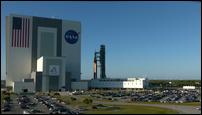Estimated read time: 5-6 minutes
This archived news story is available only for your personal, non-commercial use. Information in the story may be outdated or superseded by additional information. Reading or replaying the story in its archived form does not constitute a republication of the story.
SALT LAKE CITY — NASA officials say they're on a path to addressing hydrogen fuel leaks that have plagued both attempts to launch the Artemis I moon mission, with the second of those leaks on Saturday morning serious enough to require a scrub of the second try at launching the new rocket system.
During a press call on Thursday, Jim Free, NASA's associate administrator for the Exploration Systems Development Mission Directorate, said the agency is now shooting for launching Artemis I on either Sept. 23 or Sept. 27. The next calendar launch period opens on Sept. 19 and closes on Oct. 4.
The first launch attempt on Aug. 29 was shut down after a process to pre-cool the rocket engines in preparation for ignition failed to get one of the four engines to the required temperature of around -420 degrees Fahrenheit. In pre-launch preparations that day, NASA engineers also encountered a hydrogen leak that they eventually solved.
On Thursday, Mike Bolger, NASA Exploration Ground Systems program manager, said crews were replacing seals on two different hydrogen fueling components as the massive Space Launch System remained on its pad at Kennedy Space Center in Cape Canaveral, Florida.
Bolger said the repairs could be done as early as the end of the day on Thursday, but inclement weather in the central Florida area could push completion out a day or so. Once the seal replacements are complete, Bolger said NASA will prepare for a fueling test on Sept. 17 to ensure the repairs were successful. He also noted the fueling team would be implementing a new approach to filling SLS' liquid hydrogen tanks, a process NASA calls "tanking," by applying things they learned in the first two launch attempts.
"One thing that we've talked about with the SLS team … is a change in our concept of operation to reduce the pressure and flow changes during tanking," Bolger said. "We're calling it a kinder and gentler approach to tanking. We think that may help reduce the stress of pulses or sudden changes on the seals.
"We're optimistic we can knock this problem flat and have a successful tanking."
We're optimistic we can knock this problem flat and have a successful tanking.
–Mike Bolger, NASA
But solving mechanical issues is not the only challenge in front of NASA in order to be ready for the next launch opportunity.
Free said NASA has submitted a request to Kennedy Space Center range officials, who oversee safety issues for the facility and surrounding area, to extend a launch waiver that expired earlier this week. The launch safety waiver process is a standard requirement for all rocket launches from Kennedy. A key component of that permission is about the vitality of batteries that power the Flight Termination System, a system designed to destroy the rocket before it could become a hazard for those on the ground, should the launch veer off course.
Free said he was unable to share details publicly about how much more time NASA was hoping to have added to the waiver, which had already been bumped from the standard 20 days to 25 days earlier in the launch cycle.
In the event that Kennedy Space Center officials deny the waiver extension, the rocket system would need to be rolled off the pad and back to the vehicle assembly building for further safety checks, leading to additional launch delays.
The crewless Artemis I mission is scheduled to run for 42 days on a flight that will allow NASA experts to test the new SLS components, many of which have been repurposed from the old space shuttle program and other systems, as well as the Orion space capsule.
That capsule, the eventual home for future space travelers, will be carried into lunar orbit where it will take a spin around the moon and then head back to earth for a fiery plunge through the atmosphere at some 25,000 mph before splashing down in the Pacific Ocean at the end of the mission.
Related:
Artemis I is just the first in a three-phase program aiming to put astronauts back on the surface of the moon for the first time since the final Apollo moon visit in December 1972.
Artemis II, currently anticipated for sometime in 2024, will head to space with a four-person crew in the Orion capsule that will fly the craft around the moon in further testing. Then, if all goes according to NASA's current plan, the SLS/Orion package will return on a mission that will include a landing on the moon's surface in 2025. Along the way, NASA wants to put a small space station, the Lunar Gateway, in orbit around the moon and has future plans that include a moon base station, the Artemis Base Camp.
So, why go back to the moon?
In a posting on the Artemis missions' website, NASA lists a few reasons why it's devoting billions of dollars to making moon landings, once again, a priority.
"We're going back to the moon for scientific discovery, economic benefits and inspiration for a new generation of explorers: the Artemis Generation," NASA says. "While maintaining American leadership in exploration, we will build a global alliance and explore deep space for the benefit of all."
And while a return to the moon smacks a little of "been there, done that," NASA says it's committed to accomplishing some other first benchmarks as part of the series of Artemis missions, including extending manned exploration deeper into the solar system.
"With Artemis missions, NASA will land the first woman and first person of color on the moon, using innovative technologies to explore more of the lunar surface than ever before," NASA says in a web posting. "We will collaborate with commercial and international partners and establish the first long-term presence on the moon. Then, we will use what we learn on and around the moon to take the next giant leap: sending the first astronauts to Mars."
NASA says its SLS launch system stands at 322 feet high — taller than the Statue of Liberty — and weighs 5.75 million pounds when loaded with fuel. During launch and ascent, the SLS will produce 8.8 million pounds of maximum thrust, 15% more thrust than the Saturn V rockets that propelled Apollo astronauts to the moon.










